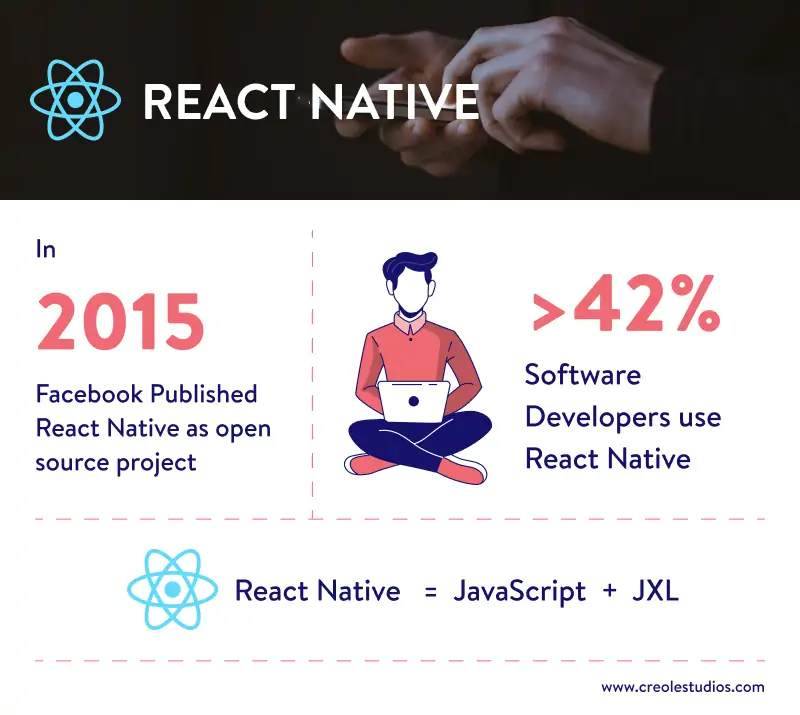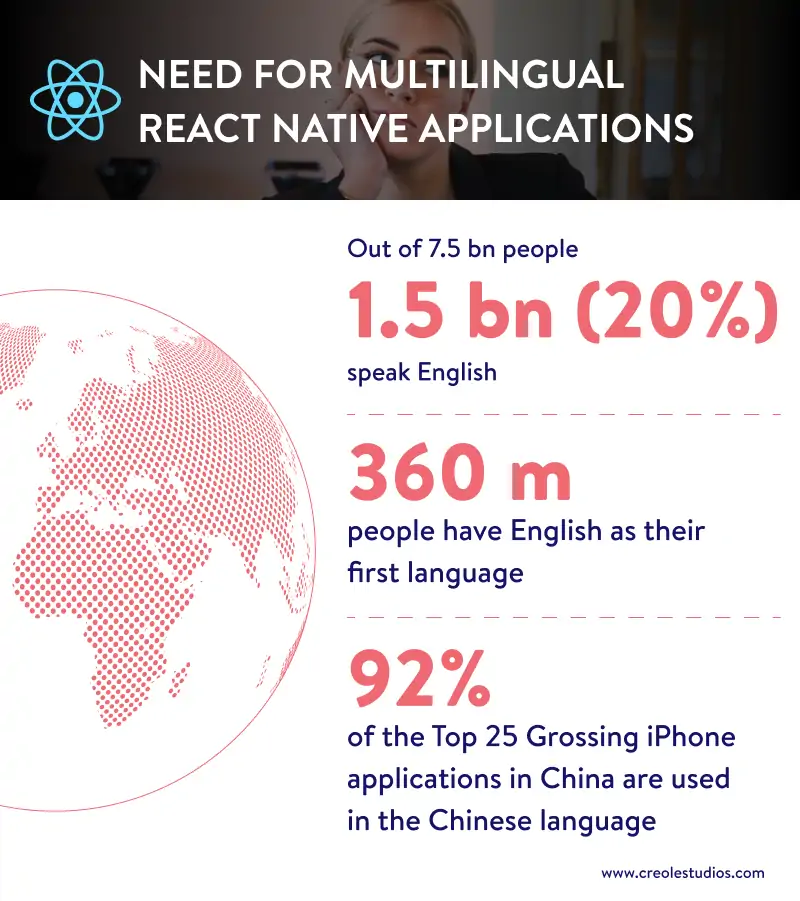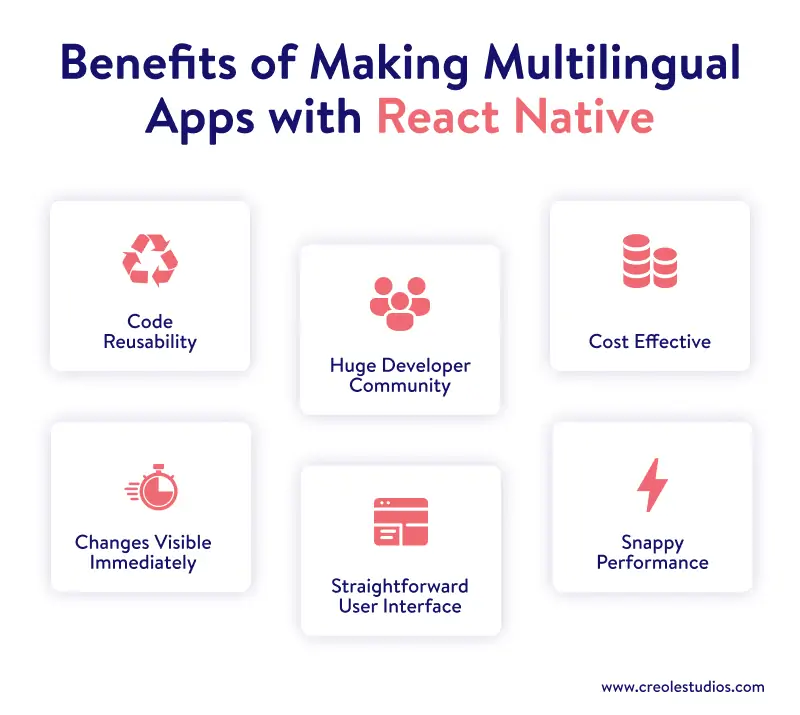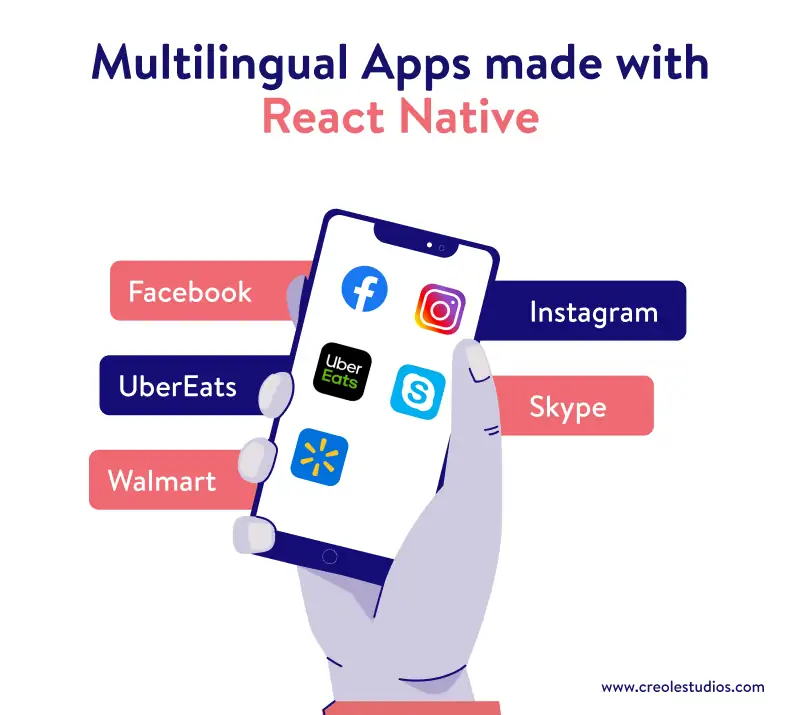As the app user base extends to new nations, it is critical that consumers are always able to utilise the app in their local language. This stems from the fact that language has always been an important element of every business and organisation. As a company expands, it frequently seeks to enter into other cities, states and countries. It is important to localise to meet the needs and requirements of locals, and this is where React Native comes into play.
The situation is no different when it comes to a mobile app.
In this article, we will first learn about React Native and app localization, and then we will look at how React Native localization is responsible for managing multilingual apps and what are its main benefits and drawbacks along with examples of various famous multilingual apps made using React Native.
What is React Native?

React Native (also known as RN) is a popular JavaScript-based mobile app framework that allows you to create natively rendered iOS and Android mobile apps. The framework enables you to develop applications for several platforms using the same codebase.
Read More: Server side Rendering with React
In 2015, Facebook published React Native as an open-source project. In just a few years, it rose to the top of the list of mobile development and hybrid development solutions.
With over 42% of software developers using React Native, it became one of the most popular cross-platform mobile frameworks in 2020. Some of the world’s most popular mobile apps, such as Instagram, Facebook, and Skype, are built with React Native. Companies that utilise React Native can write code once and use it to power both their iOS and Android apps. This leads to significant time and resource savings.
Read More: React Native vs Kotlin: Everything you need to know
How does react native function?
React Native is built in a combination of JavaScript and JXL, a unique markup language similar to XML. The framework can connect with threads in both worlds — JavaScript-based threads and existing, native app threads.
For communication, React Native employs a so-called “bridge.” While JavaScript and Native threads are created in whole separate languages, React Native uses a bridge for making bidirectional communication feasible and functional instead of creating a whole new language like Native and Java.
Need for React Native

React Native Localisations for developing multilingual apps is quite frequent since studies reveal that out of the world’s about 7.5 billion people, 1.5 billion speak English — that’s 20% of the Earth’s population. Moreover, the majority of such individuals are not natural English speakers. English is the first language of only about 360 million people.
As a result, just 360 million individuals out of 7.5 billion are fluent in English. The others speak English as a second or third language. The total market for other languages is significantly greater than the market for English alone.
When the bulk of the target audience is English-speaking, it is okay to test the market using English. However, if the intended audience speaks a different language, developers must translate the app. As the app increases in popularity, translating becomes increasingly necessary in order to serve a local audience.
It is critical for users to be able to utilise various apps without having to learn yet another language. Software developers must induce hybrid development and other modifications while writing scripts and creating codes to abandon the notion of requiring people to learn English in advance in order to operate a computer and access all of its programmes. As the barrier to creating an app or establishing a business becomes lower and lower, the quickest method to diversify is by using app localization via methods like React Native Localization (RNL) to provide translation in the language of your target audience.
What is app localization?
The act of hybrid development and modification to appeal to a geographically particular target market is known as app localization. Developers should always ensure that their mobile app is just as enticing and simple to use outside of their headquarters and country as it is within it.
App localization allows the app to be tailored to the needs of users who speak different languages, with everything from units of measurement to currencies and idiomatic phrases suited for them. Furthermore, according to statistics, 92 percent of the Top 25 Grossing iPhone applications in China are used in the Chinese language. Similar is the case with other countries and their native languages.
So, by ensuring that the mobile app is appealing to users in a wide range of places throughout the world, developers create a huge possibility for growth that they would never have been able to achieve in a single nation.
Also, successful app localization necessitates the modification of several components of the software, including:
- Correctly translating the language and creating a multilingual app.
- Changing the default currency, if applicable
- Checking to ensure that the time and date are correct for that place.
- Considering any differences in legal concerns
- Choosing the appropriate language keyboard
What is React Native Localization?
React Native localization (RNL) is the process that enables software developers to adjust internationalised applications for a given area or language by translating text and including locale-specific components. It is helpful when the developer wants to perform app localization by correctly translating the app into a particular language as per the needs of the particular place where it is being used.
Benefits of making Multilingual Apps with React Native

The following are some of the reasons for using React Native to make multilingual apps:
- Reusability of code – cross-platform development
The ability to reuse code is React Native’s most significant advantage, and it shows that apps can function successfully on various platforms – something that CEOs and Product Owners really value. They can incorporate 90% of the native framework in order to reuse code for operating systems. This benefits developers while they are creating multilingual apps as they can reuse the majority of the code to build the app in different languages.
- A strong developer community
React Native is an open-source JavaScript platform that allows developers to contribute their expertise to the development of the framework, which is available to anyone. This allows the developers to find support when they are trying to build their application in a relatively obscure language as they most likely will have community support if they run into any issues; having a beneficial influence on developing their coding abilities.
- Cost effective
Another advantage of React Native development is lower costs. As previously stated, this is due to developers’ ability to utilise the same code to create multilingual apps for both iOS and Android.
It implies that coders and developers won’t need to engage two separate iOS and Android development teams to complete the project; a small team will suffice. The cost of building apps in React Native is considerably lower than the cost of developing apps in languages that do not support cross-platform development.
- Changes visible immediately
Developers can use fast refresh to run the program while upgrading it to new versions and altering the UI. Changes are immediately visible, and the developer is saved from having to rebuild the entire software. So, when going from one language to another for a multilingual app, it saves a lot of time and effort for the developer.
This has two important advantages: time savings (since programmers save time on compilation) and greater productivity (because they do not lose any state when incorporating changes into the app).
- The user interface is straightforward
React Native development employs React JavaScript to create the app’s interface, making it more responsive and faster with less load time, resulting in a better overall user experience when it comes to multilingual apps. The framework is ideal for creating apps with both simple and complex designs because of its reactive user interface and component-based approach.
- Snappy Performance
Some argue that React Native code might have a negative impact on mobile app performance as compared to code created via Swift and other applications. Even though JavaScript is slower than native code, the difference is imperceptible to the naked eye. To demonstrate this further, developers decided to run a test comparing two versions of a basic application developed in React Native and Swift, both of which produced identical performance results. Even when it comes to developing multilingual apps, the results were no different.
- Strong application even in upcoming years
Given the rapid adoption of the framework and its straightforward approach to resolving development issues concerning multilingual apps, the future of React Native for cross-platform apps is bright. Even while it has a few drawbacks, which we will examine in the next part, its speed and ease of development make up for them.
Read More: Top 5 React UI Design Frameworks 2021
Drawbacks of making Multilingual Apps with React Native
There are two main drawbacks to creating multilingual apps with React Native. These are as follows:
- Custom modules are missing
While React Native has been around for a while, certain custom modules either need to be improved or are completely absent. This means that instead of just one codebase, you may need to run three codebases (for React Native, iOS, and Android).
Having said that, it is not a recurring thing. Unless you’re creating a new app from scratch or attempting to hack an existing one, you’re unlikely to run into these difficulties.
- Issues with compatibility and debugging
While that may come as a surprise — after all, leading tech players employ React Native – it is still in beta. The developers may encounter a variety of problems with package compatibility or debugging tools. If the developers are not skilled with React Native, this may have a slight effect on the development since they will waste time troubleshooting.
Read More: Why React JS is better than Angular or Vue JS?
Examples of Multilingual Apps made with React Native

Now that we have discussed the benefits and drawbacks, let us look at some famous multilingual apps that have been created using React Native.
UberEats
UberEats was one of the mobile apps that was built with React Native. It is distinct from the Uber app in that it comprises three parties rather than just two – restaurants, delivery partners, and diners.
This necessitated the creation of a unique dashboard that would also account for eateries. The initial dashboard, which was designed primarily for the web, limited the capacity to transmit critical information to restaurants. It also lacked access to native device features such as sound notifications, which harmed the user experience.
The team already had a lot of expertise developing in React, but not enough familiarity with Android and iOS, so choosing React Native was a no-brainer. UberEats employs a huge tech stack, of which React Native is only a minor component. However, the developers are satisfied with what it can offer and are certain that it will be able to satisfy their demands as the market expands.
Walmart
The American supermarket is known for making daring technical moves, one of which was completely rebuilding its mobile apps in React Native.
Previously, some portions of the Walmart app included integrated web views, which, according to Walmart Labs, fell short of the level that both the employees and consumers demand.
Following the switch to React Native, the performance of both iOS and Android applications increased dramatically – close to native levels. Ninety-five percent of the codebase is shared between Android and iOS, and both applications are managed and developed by a single team.
Facebook is one of the most famous React Native apps since it gave birth to and is the driving force behind the development of this programming language.
Facebook intended to bring all of the advantages of online development to mobile, such as rapid iterations and having a single product development team, and this is how React Native was born. It was originally utilised by the firm to construct its own Ads Manager app for iOS and Android.
Instagram chose to integrate React Native into its current native app, beginning with the Push notification view, which began as a WebView. Fortunately, there was no need to develop the navigation infrastructure because the UI was simple enough to function without one. Using React Native, product teams were able to increase developer velocity by 85-99%.
Skype
Another example of a React Native mobile app is Skype. In 2017, Skype stated that it was developing an entirely new app based on React Native. This sparked a lot of enthusiasm among its users, as the previous edition had a few flaws.
From the icons to the new message layout, which now includes three discussion sections: search, chat, and capture, the new app has been entirely overhauled. Microsoft, which owns Skype, had opted to employ React Native not just in the mobile app but also in the platform’s desktop version.
Bottom Line
React Native is an excellent choice if the project does not necessitate a complex interface, access to native functionality, or when developers wish to create multilingual apps for a single platform. Furthermore, React Native is a popular and appropriate alternative if one’s budget is restricted. All in all, it’s a simple, easy and budget friendly application available at everyone’s disposal!
With the help of our experts in React Native, experienced in multilingual app development, we at Creole Studios strive to provide the best services and facilities to our clients. From developing apps to developing systems for the web, we do it all. So, if you’re interested in availing our services and creating a multilingual app using React Native, contact us today!



No comments:
Post a Comment